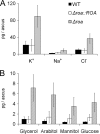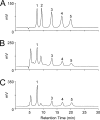A novel gene, ROA, is required for normal morphogenesis and discharge of ascospores in Gibberella zeae
- PMID: 20802018
- PMCID: PMC2950417
- DOI: 10.1128/EC.00083-10
A novel gene, ROA, is required for normal morphogenesis and discharge of ascospores in Gibberella zeae
Abstract
Head blight, caused by Gibberella zeae, is a significant disease among cereal crops, including wheat, barley, and rice, due to contamination of grain with mycotoxins. G. zeae is spread by ascospores forcibly discharged from sexual fruiting bodies forming on crop residues. In this study, we characterized a novel gene, ROA, which is required for normal sexual development. Deletion of ROA (Δroa) resulted in an abnormal size and shape of asci and ascospores but did not affect vegetative growth. The Δroa mutation triggered round ascospores and insufficient cell division after spore delimitation. The asci of the Δroa strain discharged fewer ascospores from the perithecia but achieved a greater dispersal distance than those of the wild-type strain. Turgor pressure within the asci was calculated through the analysis of osmolytes in the epiplasmic fluid. Deletion of the ROA gene appeared to increase turgor pressure in the mutant asci. The higher turgor pressure of the Δroa mutant asci and the mutant spore shape contributed to the longer distance dispersal. When the Δroa mutant was outcrossed with a Δmat1-2 mutant, a strain that contains a green fluorescence protein (GFP) marker in place of the MAT1-2 gene, unusual phenotypic segregation occurred. The ratio of GFP to non-GFP segregation was 1:1; however, all eight spores had the same shape. Taken together, the results of this study suggest that ROA plays multiple roles in maintaining the proper morphology and discharge of ascospores in G. zeae.
Figures









Similar articles
-
GzSNF1 is required for normal sexual and asexual development in the ascomycete Gibberella zeae.Eukaryot Cell. 2009 Jan;8(1):116-27. doi: 10.1128/EC.00176-08. Epub 2008 Nov 21. Eukaryot Cell. 2009. PMID: 19028993 Free PMC article.
-
Functional analyses of the nitrogen regulatory gene areA in Gibberella zeae.FEMS Microbiol Lett. 2012 Sep;334(1):66-73. doi: 10.1111/j.1574-6968.2012.02620.x. Epub 2012 Jul 3. FEMS Microbiol Lett. 2012. PMID: 22702217
-
Deletion and complementation of the mating type (MAT) locus of the wheat head blight pathogen Gibberella zeae.Appl Environ Microbiol. 2004 Apr;70(4):2437-44. doi: 10.1128/AEM.70.4.2437-2444.2004. Appl Environ Microbiol. 2004. PMID: 15066842 Free PMC article.
-
Recent advances in genes involved in secondary metabolite synthesis, hyphal development, energy metabolism and pathogenicity in Fusarium graminearum (teleomorph Gibberella zeae).Biotechnol Adv. 2014 Mar-Apr;32(2):390-402. doi: 10.1016/j.biotechadv.2013.12.007. Epub 2014 Jan 2. Biotechnol Adv. 2014. PMID: 24389085 Review.
-
Fungal cannons: explosive spore discharge in the Ascomycota.FEMS Microbiol Lett. 2007 Nov;276(1):12-8. doi: 10.1111/j.1574-6968.2007.00900.x. Epub 2007 Sep 3. FEMS Microbiol Lett. 2007. PMID: 17784861 Review.
Cited by
-
Survival Factor Gene FgSvf1 Is Required for Normal Growth and Stress Resistance in Fusarium graminearum.Plant Pathol J. 2019 Oct;35(5):393-405. doi: 10.5423/PPJ.OA.03.2019.0070. Epub 2019 Oct 1. Plant Pathol J. 2019. PMID: 31632215 Free PMC article.
-
Soybean Stem Canker Caused by Diaporthe caulivora; Pathogen Diversity, Colonization Process, and Plant Defense Activation.Front Plant Sci. 2020 Jan 23;10:1733. doi: 10.3389/fpls.2019.01733. eCollection 2019. Front Plant Sci. 2020. PMID: 32117332 Free PMC article.
-
Determination of motility forces on isolated chromosomes with laser tweezers.Sci Rep. 2014 Oct 31;4:6866. doi: 10.1038/srep06866. Sci Rep. 2014. PMID: 25359514 Free PMC article.
-
Functional analyses of two acetyl coenzyme A synthetases in the ascomycete Gibberella zeae.Eukaryot Cell. 2011 Aug;10(8):1043-52. doi: 10.1128/EC.05071-11. Epub 2011 Jun 10. Eukaryot Cell. 2011. PMID: 21666077 Free PMC article.
-
Advances in Understanding Fusarium graminearum: Genes Involved in the Regulation of Sexual Development, Pathogenesis, and Deoxynivalenol Biosynthesis.Genes (Basel). 2024 Apr 9;15(4):475. doi: 10.3390/genes15040475. Genes (Basel). 2024. PMID: 38674409 Free PMC article. Review.
References
-
- Aylor D. E., Anagnostakis S. L. 1991. Active discharge distance of ascospores of Venturia inaequalis. Phytopathology 81:548–551
-
- Beckett A. 1981. Ascospore formation, p. 107–129 InTurian G., Hohl H. (ed.), The fungal spore: morphogenetic controls. Academic Press, London, United Kingdom
-
- Bowden R. L., Fuentes-Bueno I., Leslie J. F., Lee J., Lee Y.-W. 2008. Methods for detecting chromosome rearrangements in Gibberella zeae. Cereal Res. Commun. 36(Suppl. 6):603–608
-
- Cappellini R. A., Peterson J. L. 1965. Macroconidium formation in submerged cultures by a non-sporulating strain of Gibberella zeae. Mycologia 57:962–966
-
- De Jong J. C., McCormack B. J., Smirnoff N., Talbot N. J. 1997. Glycerol generates turgor in rice blast. Nature 389:244–245
Publication types
MeSH terms
Substances
LinkOut - more resources
Full Text Sources

